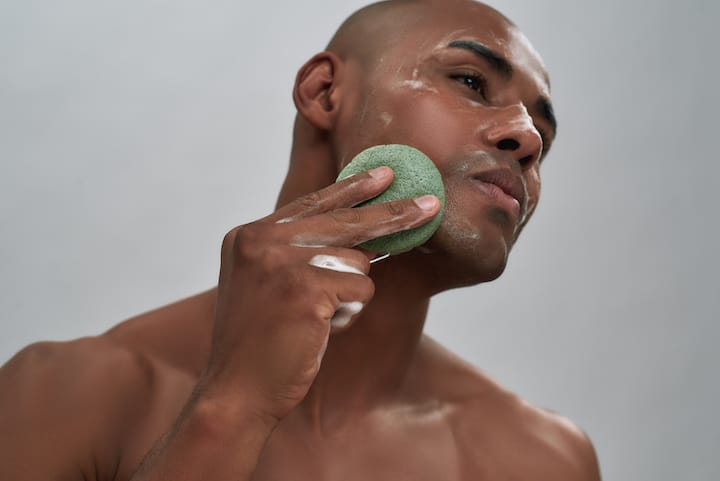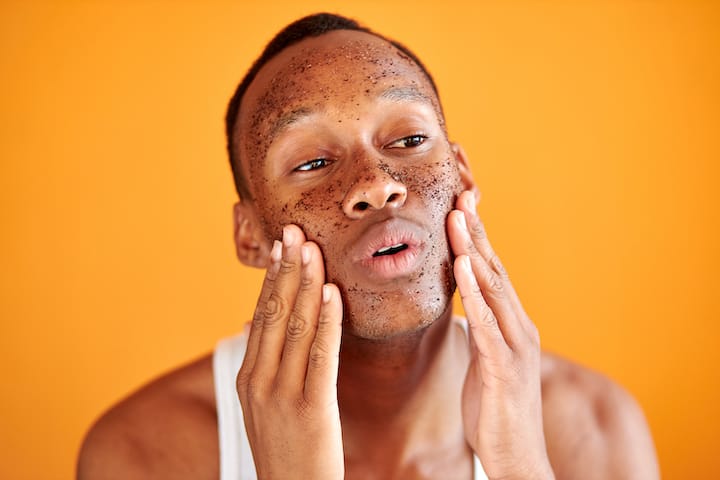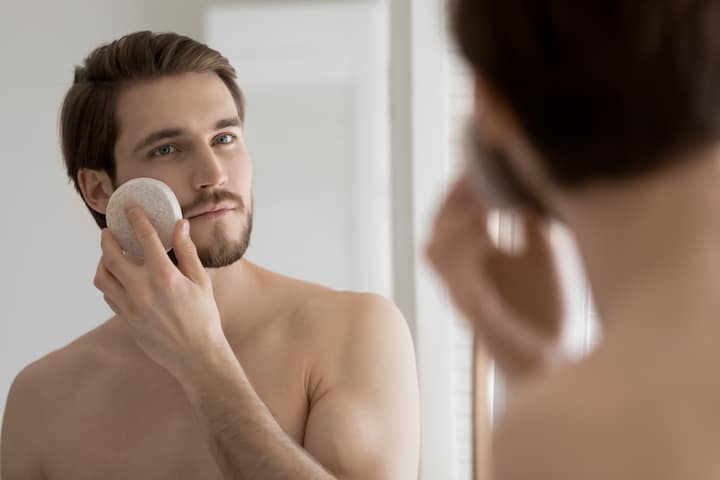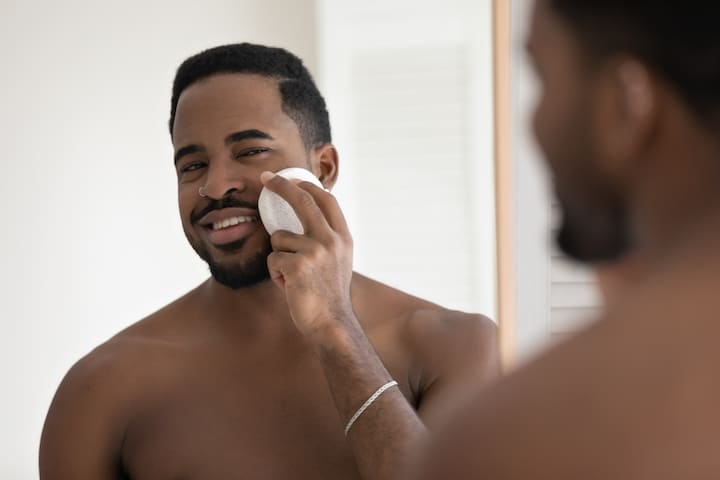One of the key questions among men who aim to keep their skin smooth is whether to exfoliate before or after shaving.
There are actually facts that support both sides, even though most people do it before.
However, it doesn’t have to be this way as general opinion doesn’t have to be always right.
Exfoliation is a very important process for skincare as you remove all the dead cells from your face that don’t shed naturally.
By doing so you massively help your face be smoother and healthier.
If you are uncertain when to exfoliate, particularly before or after shaving, our article will provide you with all the ins and outs of this predicament.
Once you know how to do it properly, you will be able to gain extraordinary results and make your face as smooth as a baby’s bottom.
Table Of Contents
What Is Exfoliation
This is the process where you remove dead skin cells that aren’t shed naturally. When exfoliating, you can use chemical exfoliators or scrubs.
You can also use exfoliating tools such as bath sponges. A shaving brush is a great option for lathering as well as exfoliation.
Straight razors also come with an exfoliating side that exfoliates your skin as you continue shaving.
Benefits of Exfoliation
Your skin goes through so many changes during the day. For instance, skin cells die and fall off. Those that don’t fall off naturally remain on your skin and beard if you have one.
Over time, dead skin cells can end up clogging your pores which leads to acne breakout. To prevent this, make sure that you exfoliate your skin from time to time, and here is why.
Removes Dead Skin Cells
When you don’t exfoliate, the dead skin cells remain on top of healthy skin, leading to all manner of health issues, including acne.
Exfoliation helps prevent a build-up of dead cells from making way for healthy cells. If you have a beard, choosing exfoliators for men that refresh skin will go a long way in maintaining healthy skin.
Contributes to Better-Looking Skin
The removal of dead skin cells makes your skin look fresh and healthier. The skin will look dull, dry, and flaky without exfoliation even after using skin care products like lotions and moisturizers.
Unclogs the Pores
Clogged pores on the face or body are the last thing you want. Clogged pores contribute to acne, razor burns, and even ingrown hairs.
One of the best ways of unclogging pores is using exfoliators. Exfoliation helps remove dirt, dried-up sebum, and ingrown hairs that may be clogging the pores.
Makes Shaving Easy
When shaving, your razor picks up hair as well as dead skin cells, dirt, and oil. These get stuck on the razor, which forces you to go over the skin multiple times, leaving you prone to irritation.
Exfoliating your skin means a smooth base for shaving since the razor only needs to remove the hairs.
How Does It Work
Your skin goes through a natural process where skin cells die as others are produced. The dead skin cells remain on the skin and some may be washed off when you are cleaning your face.
Most, however, remain on the skin forming a barrier on top of the healthy skin. If they are not removed, they can clog the pores leading to health issues like acne.
For men who have beards, dead skin cells also contribute to all shaving nuisances like ingrown hairs and razor burns.
Exfoliation works to remove the dead skin cells, oil, and dirt on the skin. You can either use chemical exfoliators, scrubs, or things like sponges and razors.
Your skin may look dull and flaky when the buildup of dead skin cells becomes too much. After exfoliating, the skin regains its natural glow and appears brighter and healthier.
Pros and Cons
Pros
- Exfoliation removes dead skin cells, which clog the pores to prevent breakouts and blackheads.
- When dead cells are removed, your skin becomes moisturized and has that natural glow of healthy skin.
- By removing dead cells, moisturizing helps eliminate shaving issues like razor burns and ingrown hairs.
- When dirt and dead skin cells build up, it can result in uneven skin tone. Exfoliating restores the skin’s color and gives you an even complexion.
- Exfoliating helps skincare products like moisturizers and acne creams penetrate better into the skin.
Cons
- Over-exfoliation can lead to more sensitive skin prone to razor burns, cuts, and nicks when shaving.
- Sometimes exfoliating too much can also leave your skin looking drier than usual.
- Some exfoliating creams contain ingredients that may wreak havoc on your skin.
Types
Chemical
Chemical exfoliation involves the use of chemicals to dissolve dead skin cells. Chemical exfoliates use ingredients like alpha and beta hydroxy acids.
Alpha-hydroxy acids include glycolic, tartaric, lactic as well as citric acids. These break apart the bonds that hold dead skin cells on the skin’s surface so that the skin can shed them off naturally.
Beta-hydroxy acids, on the other hand, include salicylic and beta hydroxyl acid. These are more ideal for use on skin that is prone to acne breakouts.
Physical
Physical exfoliates involve the use of physical scrubs and tools to remove dead skin cells. They include the everyday scrub, exfoliating brush, sponge, and exfoliating gloves.
An exfoliating scrub is applied directly to the skin and rubbed in a gentle circular motion. It scrubs off dead skin cells before rinsing your face with cold water.
An exfoliating brush is a bristle brush used on the skin to remove dead skin cell layers. Some brushes are meant for dry scrubbing, while others have to be used with a body wash or facial cleanser.
An exfoliation sponge offers a gentle way to remove dead skin cells. Wet the sponge and then apply body wash or soap and begin scrubbing the face.
An exfoliation glove is a glove that has an exfoliating surface. It can be a great option if you don’t want to use sponges or brushes to exfoliate.
Lather the glove with body wash or soap when in the shower. The good thing about an exfoliating glove is that it can be used on even larger areas like the arms and legs.
Exfoliating Before Shaving vs After Shaving
The big question for most men is whether to exfoliate before or after shaving. Exfoliation should come before you shave and here is why.
Exfoliation not only helps clean the face but also creates a smooth base for the razor. It should be part of your pre-shaving routine even before you use your pre-shave oil with natural ingredients.
Exfoliation lifts your hairs allowing the razor to slide smoothly without pulling or tugging the follicles, which lead to cuts and nicks.
This process of lifting the hairs allows for a smooth close shave and makes it easy for the shaving cream to penetrate deeper into the skin, which offers protection gains razor burns.
At the same time, exfoliating before you shave also helps prevent ingrown hairs since it removes the dead skin cells.
Usually, dead skin cells clog up the pores and hair follicles, trapping hair under the skin, which forces it to curl and grow inwards rather than outwards.
Exfoliating after shaving could leave your skin prone to irritation. Why? When you shave, the razor disrupts the skin surface, creating micro-cuts and abrasions.
Whether you are using a chemical or physical exfoliate, your skin surface will be disrupted either way. Exfoliating after shaving will leave your skin feeling more irritated and sensitive.
How to Choose the Best Exfoliation Method
Skin Type
If you have dry and flaky skin, avoid mechanical exfoliates since they will dry your skin, even more, leading to micro-tears.
Alpha-hydroxy acids are best for dry skin. Glycolic acid, for instance, removes dead skin cells leading to skin rejuvenation.
Follow that up with moisturizer and SPF since glycolic acid can leave your skin prone to sun damage.
If you have sensitive skin, avoid scrubs, as these will irritate the skin further. Instead, use mild chemical exfoliates. If you are prone to acne, a salicylic acid peel will also work.
If you have oily skin, mechanical exfoliation and brushing will work for you. Oily skin tends to have an extra layer of oil buildup.
For normal skin, any method of exfoliation will work. You may have to experiment with different exfoliates until you find one that works best for you.
For combination skin, a mixture of chemical and mechanical exfoliation will do. However, don’t use both exfoliation methods simultaneously, and make sure that you follow it up with a moisturizer.
Exfoliating Ingredients
Both mechanical and chemical exfoliates contain different ingredients that may or may not work for you. It all comes down to your skin type.
If you have sensitive skin especially, you need to ensure that the exfoliate you are using doesn’t contain ingredients that may irritate your skin even more.
At the same time, some exfoliates might contain ingredients that could leave your skin drier, especially if you already have dry skin.
Scrubbing Beads
Physical scrubs contain beads that remove the dead skin cells, oil, and dirt from the skin. The size of the beads will determine the outcome of the exfoliation process.
At the same time, if you are environmentally conscious, go for an exfoliate that contains natural beads rather than plastic ones.
Moisturization
Exfoliation dries your skin after. As such, you need to have a moisturization plan in action. Suppose you have a moisturizer; apply it immediately to keep your skin hydrated.
At the same time, go for exfoliates that have moisturizing properties, especially if you are using chemical peels.
Amount
This comes down to how many times you will be exfoliating your skin. Of course, over-exfoliation can leave your skin irritated and more prone to sun damage in the long run.
Chemical exfoliates are always more expensive than physical scrubs. You need to ensure that you get value for your money, especially if you exfoliate a lot.
How to Exfoliate Before Shaving
Step 1 – Use warm water to rinse your face
Before you begin exfoliating, rinse the face with warm water. Warm water opens the pores so that the exfoliate can penetrate deep into your skin and make shaving easy.
Step 2 – Apply your exfoliate
Apply a small amount of exfoliating agent and massage it over your skin. If you are using a scrub, scrub in a circular motion gently. Exfoliate both the skin and the face.
If you are using a chemical peel, apply it to your face and leave it for the recommended minutes.
Step 3 – Rinse and prepare to shave
Once you are done exfoliating, rinse your face with warm water. After that, apply your regular shaving cream.
Shaving cream softens the hair for a close and smooth shave. You can also apply a premium shaving gel to soften your beard for easier shaving.
After that, you can go ahead and begin shaving with your chosen razor. Safety razors can help you achieve your desired look quickly, but you might also enjoy the ergonomic handle of disposable razors.
Shave in the direction the hair is growing to ensure no pulling and tugging, leading to irritation and razor burns.
If you don’t have a beard but have always wanted to know what it feels like to shave, you can always learn to grow a big beard using beard growth formulas.
If you want to shape your beard, use a professional shaping tool.
Step 4 – Rinse your face with cold water
When you are satisfied with the shave, splash cold water on your face. Cold water closes the pores that had opened up when shaving. It also leaves your face feeling fresh and less irritated.
Step 5 – Aftershave care
Exfoliation and shaving disrupt the skin and you need to replenish the moisture lost. Apply a nice after-shave balm to restore moisture.
How to Take Care of Your Skin After Shaving
Step 1 – Rinse with cold water
This is an important step that most men tend to skip. Using cold water helps close up the pores, so that dirt, oil, and bacteria don’t clog the pores again.
The other reason why you need to use cold water is that it soothes already irritated skin.
Step 2 – Dry your skin gently
Use a towel to dry your face. Use a clean towel and pat dry rather than rubbing to ensure that you don’t irritate your face more.
Step 3 – Apply aftershave
Aftershave has so many benefits, like restoring moisture. On top of that, aftershave leaves you smelling great and fresh.
Step 4 – Wear sunscreen when going out
Exfoliating your skin can leave it more prone to sun damage. As such, you need to use quality sunscreen when you are going out.
Wet Shaving vs Exfoliation
To exfoliate or rely on traditional wet shaving to remove dead skin? Both work just fine. Wet shaving especially, when you use a brush to apply shaving cream, exfoliates the skin.
At the same time, shaving requires you to make multiple passes with your razor removing dead skin cells.
When it comes to exfoliating, using a brush and shaving cream can be exfoliation on its own. The brush matters, though. If you are using a thick-bristled brush, then don’t exfoliate your skin before.
If you make multiple passes when shaving, you don’t want to exfoliate your skin beforehand.
Making multiple passes is enough to remove dead skin cells, but the same also leave your skin irritated.
When it comes to exfoliating before shaving, ensure that you don’t use very strong exfoliating methods.
Every pass of the razor leaves the skin irritated. As a result, rough and coarse scrubs and chemical exfoliating methods will dry your skin and irritate it further.
When the skin is dry, the body will compensate for that by producing more oil, leaving you prone to acne breakouts.
If you are doing any wet shaving, use a gentle brush and gentle or mild exfoliate. Should you use a rough scrub or chemical exfoliate, give your skin some time to recover before the next exfoliation.
Do’s and Don’t
Do’s
- Be gentle when exfoliating and make sure that you understand your skin type. If you have oily skin, for instance, be gentle and exfoliate more often.
- Use warm water to open the pores first so that the exfoliate can penetrate deep into your skin.
- If you experience any side effects with the exfoliating products you are using, discontinue use immediately.
- Make sure that you wear sunscreen after exfoliating and shaving.
- Start simple and exfoliate once or twice a week, preferably before you go to bed.
Don’ts
- Don’t over-exfoliate as this leaves your skin dry and irritated. While at it, don’t exfoliate every day.
- When you are using a facial scrub, don’t apply too much pressure.
- Don’t exfoliate if your skin is already irritated. Instead, allow your skin to heal first.
FAQ
How often should I exfoliate my face?
Exfoliating two to three times a week is okay but make sure that your skin can handle it. If you have sensitive skin, avoid exfoliating more than you need to.
Is it better to exfoliate in the morning or evening?
It’s usually better to exfoliate in the evening before you go to bed. When at rest, your skin will repair better than during the day when it’s exposed to damage from the sun and free radicals.
Can I exfoliate if I have acne?
Yes, you can exfoliate if you have acne. Exfoliating soothes and softens your skin. At the same time, exfoliating when you have acne opens the pores and prevents more breakouts.
What if I shave then exfoliate?
It’s always best to exfoliate before you shave. The multiple passes of the razor will leave your skin irritated. Exfoliating after that dries the skin further and worsens the irritation.
What should I use to exfoliate after shaving?
If you still want to exfoliate after shaving, use a very mild chemical exfoliate.
How do you exfoliate your pubes before shaving?
Use a gentle chemical exfoliate or a gentle scrub to exfoliate before you shave. Make sure that the exfoliate contains ingredients that can’t harm your skin.
Which exfoliation products work best?
It all depends on your skin type. For instance, alpha-hydroxy acids work best for dry skin, while scrubs work well for oily skin.
Jay is one of the members of the Beardoholic writers team and NFL, celebrity barber. As a master barber with years of experience, Jay can make your beard look any way you envision. Jay’s specialty is black men’s hair and beard styles, but he also has deep knowledge on how to create a perfect neck and cheek line, short or long beard and virtually any beard and hair shape and style.






